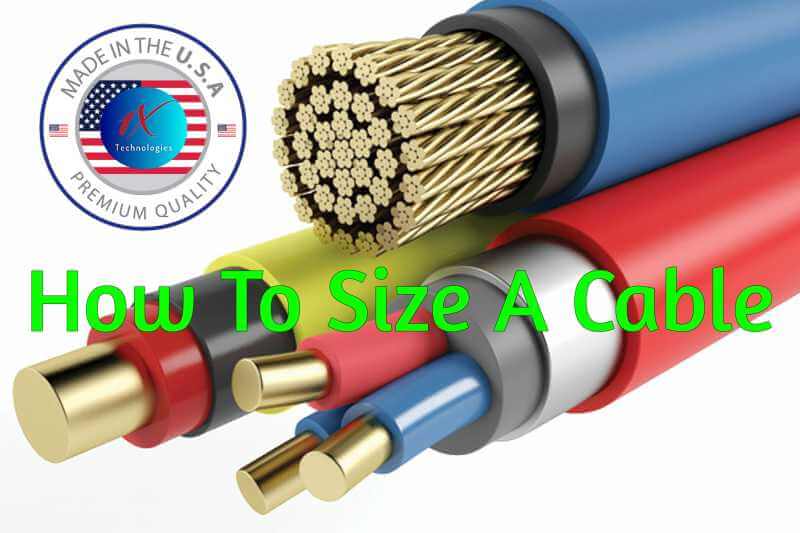How to size a cable, Conductor sizing per the [NEC] National Electrical Code Experts in the USA
We wrote this article because every single day we are asked by electrical engineers, electrical contractors, and others in the electrical construction field about “How to Size a Cable“.
This article will be a good reference guide for how to size a cable, and we will also include a PDF version of how to size a cable so you can take it with you or save it to your device for a quick cable sizing guide.
If you are reading this and don’t find exactly the reference you need please send us a message with how you think we can improve this to better suit your cable sizing needs.
With the extra-large cables we manufacture, over 1000 KCMIL up to 6000 MCM, we field calls for this question every day.
This will be a fantastic reference point for you to save or bookmark for future use.
We aim for this to be the most comprehensive guide on how to size a cable on the web.
The Quick Answers for How to size a cable!
- If you are looking for the quick answer to How to size a cable, scroll down to the Yellow highlighted text and find the word “Simple” for the easy answer.
- Furthermore, continue to the Pink text for the longer answer with the word variables!
- Tip: Either choice, click play the SoundCloud link below and listen to Paul walk you through it if you have a little time. Worth it!
P.S. If you aimed the long answer you may want to check out The difference between a good and bad electrician!
How to size a cable: 1X Technologies on Soundcloud
Click the orange and white play button below to listen to this podcast on how to size a cable while you read along.
It will play right here in your browser while you’re on this page.
First, these are the top 15 questions we commonly get on How to size a cable
We have compiled our data and determined that these exact questions are asked the most frequently regarding conductor sizing.
We listed the top 100 “How to size a cable questions” at the very bottom, you’ll have to click read more to see them if interested.
See if any of these are exactly what lead you here, or if they are close to what you searched on how to find how to size a cable:
- How do we measure the correct cable size?
- How do we determine the right size wire?
- how to measure power cable size?
- how to measure a cable size?
- how to size an electrical cable?
- how to size armored cable?
- how to select a cable size for particular load?
- how to calculate size of cable?
- how to work out a cable size?
- how to size 3 phase cable?
- how to size medium voltage cable?
- how to size high voltage cable?
- how to size low voltage cable?
- how to size a battery cable?
- how to size an electrical cable per the NEC?
One common theme for all “How to Size a Cable” Questions:
It might seem like a waste of time to share what the most popular questions we get on cable sizing, but we shared the results for two important reasons.
- To let you know you are not an idiot. Some of the smartest people in the world want to know the proper way to size a cable.
- To let you know that while each way the question if phrased by each different electrical professional it all comes back to the one simple answer when determining sizing of cables here in the United States. How to properly size a cable per the NEC. All roads lead to Rome and all those questions above (15) and below (100) lead to the same place, here!
At what point in the electrical construction process does “how to size a cable?” questions come up the most?
Just like you, these electrical professionals want to be sure they are measuring cables sizes the right way and they turn to us to help them get the right cable size for their project.
Yes, This comes up in the ordering process, but most of the time it happens during the initial estimation of a new construction project when sizing a cable is most important.
Across the United States at any given moment there are thousands of hard-working electrical construction professionals pulling wire or installing cable to keep America running strong.
From New York to Los Angeles, from Houston Texas to the Motor City, Detroit Michigan and everywhere in between there is someone just like you trying to figure out the same thing you are right now.
The work you do is important and sizing a cable the right way is critical for the infrastructure of American.

How the heck do I make sure this cable is the right size per the NEC?
We have compiled information here for you from numerous electrical resources in the area of electrical code including Paul Abernathy and his Electrical Code Academy, Mike Holts Forum, EC&M Magazine, Electrical Contractor Magazine, and other great resources to get you the answer to How to Size a Cable:
How to size a cable per the NEC without variables, the simple answer from Paul Abernathy:
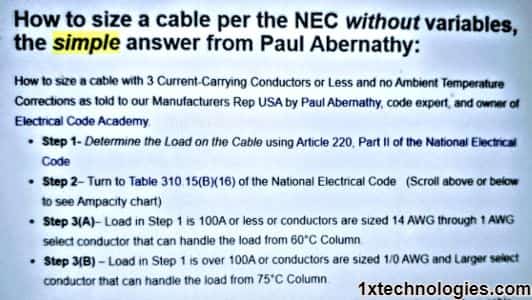
- Step 1- Determine the Load on the Cable using Article 220, Part II of the National Electrical Code
- Step 2– Turn to Table 310.15(B)(16) of the National Electrical Code (Scroll above or below to see Ampacity chart)
- Step 3(A)– Load in Step 1 is 100A or less or conductors are sized 14 AWG through 1 AWG select conductor that can handle the load from 60°C Column.
- Step 3(B) – Load in Step 1 is over 100A or conductors are sized 1/0 AWG and Larger select conductor that can handle the load from 75°C Column.
If you like the podcast we shared above and have 2 hours to listen to a master at work on cable sizing, here is a fantastic video by Paul Abernathy:
How to Size a Cable per the NEC with variables:
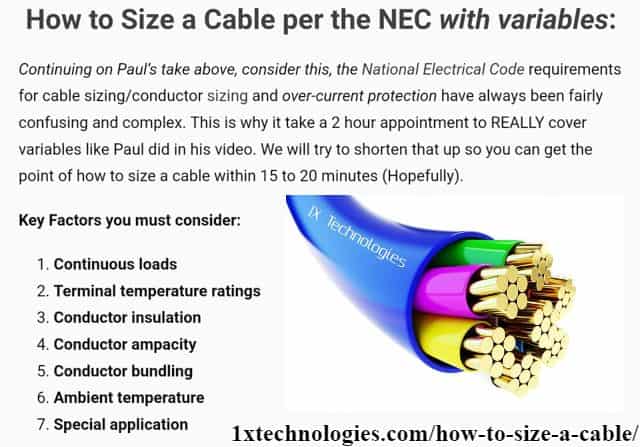
Continuing on Paul’s take above, consider this, the National Electrical Code requirements for cable sizing/conductor sizing and over-current protection have always been fairly confusing and complex. This is why it take a 2 hour appointment to REALLY cover variables like Paul did in his video. We will try to shorten that up so you can get the point of how to size a cable within 15 to 20 minutes (Hopefully).
Key Factors you must consider:
- Continuous loads
- Terminal temperature ratings
- Conductor insulation
- Conductor ampacity
- Conductor bundling
- Ambient temperature
- Special application
NEC 240.4 Cable Sizing from Mike Holt
NEC 240.4 requires the branch circuit, feeder, and service conductors to be protected against overcurrent.
This is in accordance with their ampacities as specified in 310.15. Section 240.4(A) through (G) contains rules that modify the general requirement and permit conductors to be protected in a manner other than their ampacities from 310.15, including:
- Power Loss Hazard [240.4(A)]
- Overcurrent Devices Rated 800A or Less [240.4(B)]
- Small Conductors [240.4(D)]
- Tap Conductors [240.4(E)]
- Transformer Secondary Conductors[240.4(F)]
- Air-Conditioning and Refrigeration Equipment Circuit Conductors [240.4(G)]
- Capacitor Circuit Conductors [240.4(G)]
- Electric Welder Circuit Conductors [240.4(G)]
- Fire Alarm System Circuit Conductors [240.4(G)]
- Motor-Operated Appliance Circuit Conductors [240.4(G)]
- Motor and Motor-Control Circuit Conductors[240.4(G)]
- Phase Converter Supply Conductors [240.4(G)]
- Remote-Control, Signaling, and Power-Limited Circuit Conductors [240.4(G)]
Cable Size Selection Chart – NEC Ampacities Chart for How to Size a Cable
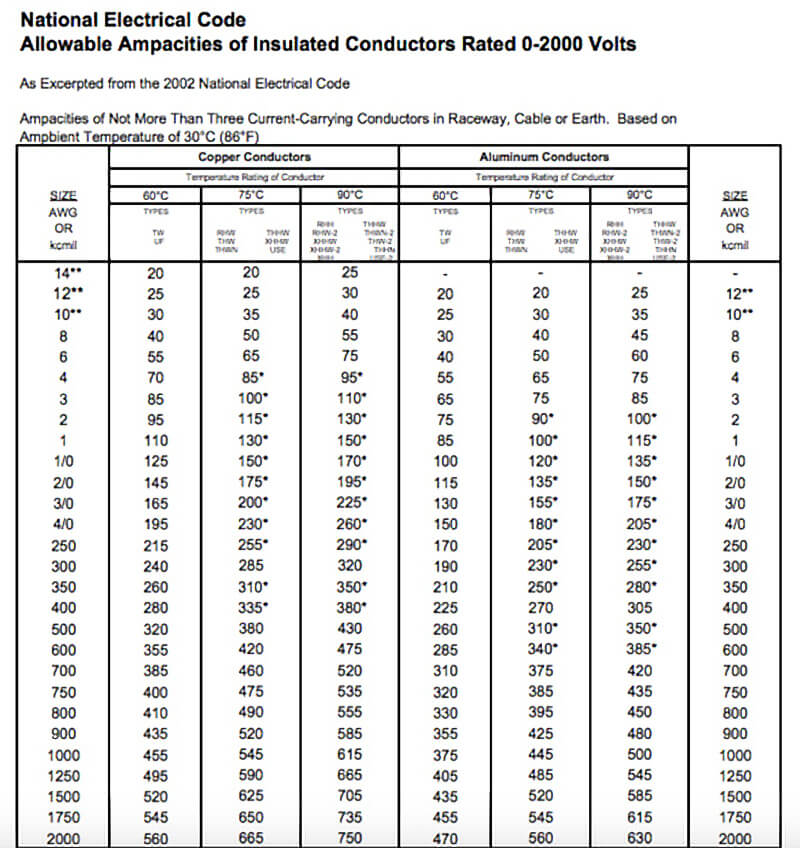
The following steps and examples should help you understand the basic rules of how to size a cable per the NEC:
- Step 1 – Size the overcurrent device in accordance with 210.20(A) and 215.3. These two NEC rules require the overcurrent device (breaker or fuse) be sized no less than 100% of the noncontinuous load, plus 125% of the continuous load.
- Step 2 – Select the conductor to comply with 210.19(A), 215.2, and 230.42(A). Sections 210.19(A), 215.2 and 230.42(A) require the conductor to be sized no less than 100% of the noncontinuous load, plus 125% of the continuous load. In addition, 110.14(C) requires consideration of the temperature rating of the equipment terminals when sizing conductors. Circuit conductors must be sized according to the 60°C column of Table 310.15(B)(16) for equipment rated 100 amperes and less, unless marked otherwise, and equipment rated over 100 amperes must be sized to the 75°C column of Table 310.15(B)(16) [110.14(C)]. The purpose of this rule is to ensure that the heat generated on equipment terminals can be properly dissipated without damaging the conductors. For all practical purposes, most electrical equipment is designed to accept conductors sized to the 75°C column of Table 310.15(B)(16).
- Step 3 – The selected conductor must be protected against overcurrent in accordance with 240.4. This requires the branch circuit, feeder, and service conductors be protected against overcurrent in accordance with their ampacities as specified in Table 310.15(B)(16).
Branch Circuit Continuous Load Example for How to Size a Cable
What size branch-circuit over-current protection device and conductor (THHN) is required for a 23A continuous load (75°C terminals).
- Step 1 – Size the overcurrent protection device in accordance with 210.20(A) – The branch-circuit overcurrent protection device must be sized not less than 125% of 23A. 23A x 125% = 28.75A or 30A [240.6(A)]
- Step 2 – Select the conductor to comply with 210.19(A), which requires the branch-circuit conductor to be sized no less than 125% of the continuous load, 23A x 125% = 28.75A. The conductor is selected to the 75°C temperature rating of the equipment terminals in accordance with Table 310.15(B)(16). In this case, 10 THHN having a rating of 35A at 75°C is suitable.
- Step 3 – We must ensure the conductor is protected against overcurrent in accordance with the requirements of 240.4. Again in this case, 10 THHN (from Step 2) rated 35A [Table 310.15(B)(16) is protected by the 30A protection device.
Feeder Continuous Load Example for How to Size a Cable:
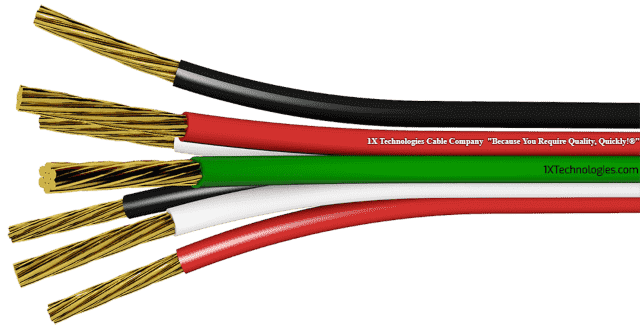
Feeder Continuous Load Example for How to Size a Cable:
What size feeder overcurrent protection device and conductor (THHN) is required for a 184A continuous load on a panelboard (75°C terminals).
Step 1 – Size the overcurrent device in accordance with 215.3. The feeder overcurrent device must be sized not less than 125% of 184A, 184A x 125% = 230A. According to 240.6(A) we must select a minimum 250A overcurrent device.
Step 2 – Select the conductor to comply with 215.2, which requires the feeder conductor to be sized no less than 125% of the continuous load, 184A x 125% = 230A. We must select the conductor according to the 75°C temperature rating of the panelboards terminals [110.14(C)] – 4/0 THHN has a rating of 230A at 75°C will meet this requirement.
Step 3 – Verify the conductors selected in Step 2 is properly protected against overcurrent in accordance with 240.4. The 4/0 AWG conductor from Step 2 is rated 230A at 75°C, it is permitted to be protected by a 250A protection device in accordance with the “the next size up rule” of 240.4(B).
Preventing Fire and Overheating with NEC minimum cable size requirements for cables to comply with OSHA Safety
The NEC provides minimum size requirements for conductors to prevent overheating and fire. Insulation type, ambient temperature, and conductor bundling are three primary factors in determining how big a conductor has to be for it to safely carry the current imposed on it.
A key concept in conductor sizing is understanding the definition of ampacity. The ampacity of a conductor is the amount of current the conductor can carry continuously under specific conditions of use [Art. 100 definition]. The ampacity of a conductor is not what size breaker can be used to protect the wire; it is simply the amount of current the conductor can carry. It is important to recognize this subtlety.
YouTube Video OSHA Electrical Safety Presentation (38 Mins 16 seconds)
This is an excellent electrical presentation by Rodney Sherman given at Holy Cross Energy. It will make a believer out of you.
Video from the actual OHSA Acadamy course, you can check out the course here.
Temperature correction in cable sizing
Table 310.16 lists ampacities under two conditions: 1) no more than three current-carrying conductors bundled together, and 2) an ambient temperature of 86°F (30°C). If either of these two values changes, the ampacity of the conductor must change as well. If you look at the bottom of Table 310.16, you’ll see temperature correction factors in 5°C increments from 21°C through 80°C.
Sizing cables per Conductors and Temperature
When sizing conductors, you can’t use a temperature rating any higher than the lowest temperature rating of any connected termination or device [110.14(C)]. Generally, you don’t find terminals rated above 75°C, so why is there a 90°C column for conductors? True, most terminations simply aren’t rated to carry 90°C, but remember that when you adjust the ampacity of a conductor due to ambient temperature or conductor bundling, you use the 90°C column to begin the calculation (assuming you are using a conductor 90°C insulation rating). Read through example D3(a) in Annex D, and you’ll understand exactly why this column exists.
Mike Holt: Practice example for sizing a cable, how to size a cable.
What’s the minimum size THHN/THWN conductor you can use to supply a 40A noncontinuous load in a dry location, if the conductors pass through an ambient temperature of 100°F (Fig. 1)?
Corrected Ampacity = Table 310.16 Ampacity × Ambient Temperature Correction Factor
For a dry location, use the 90°C column for THHN.
Ambient Temperature Correction Factor for 100°F = 0.91 for THHN
Table 310.16 ampacity for 10 THHN is 40A at 90°C in a dry location
10 THHN = 40A × 0.91 = 36.40A. This is too small for the 40A load.
Table 310.16 ampacity for 8 THHN is 55A at 90°C in a dry location: Use the THHN 90°C column.
8 THHN = 55A × 0.91 = 50A
Therefore, an 8 AWG conductor is the answer to this question.
If this were in a wet location, would 8 THHN/THWN still be adequate?
Table 310.16 ampacity for 8 THWN is 50A at 75°C in a wet location: use the THWN 75°C column.
Ambient Temperature Correction Factor for 100°F = 0.88 for THWN
8 THWN = 50A × 0.88 = 44A
The conductor must have an ampacity of at least 40A, after applying the ambient temperature correction factor, in order to carry the load. In this example, the 8 THHN/THWN has sufficient ampacity after correction in either a wet or dry location. That either/or result is not always the case, so pay attention to the wet/dry question when using conductors with dual-rated insulation types, and use the column that corresponds to the location. In addition, keep in mind that a conductor with a “-2” after its insulation, such as THHN/THWN-2, is rated 90°C in a wet, dry, or damp location[Table 310.13(A)].
What if you have conductors installed in raceways exposed to direct sunlight on or above rooftops? In such cases, add the ambient temperature adjustment in Table 310.15(B)(2)(c) to the outdoor ambient temperature when applying ampacity adjustment correction factors contained in Table 310.16.
Bundling: How to size bundled cable

When conductors are bundled together, they lose some of their ability to dissipate heat. In the NEC, the allowable ampacity starts dropping when four or more current-carrying conductors are bundled together for more than 24 inches [310.15(B)(2)(a)] (Fig. 2).
Be aware that there are five exceptions described in 310.15(B)(2)(a), one of which is for AC or MC cable, which allows up to 20 current-carrying conductors in 12 AWG, 2 or 3 conductor cables without having to adjust the ampacity.
If the ambient temperature is anything but 86°F — and more than three current-carrying conductors are bundled together — adjust the ampacity (listed in Table 310.16) for both conditions.
To make that cable sizing adjustment, multiply these three numbers together:
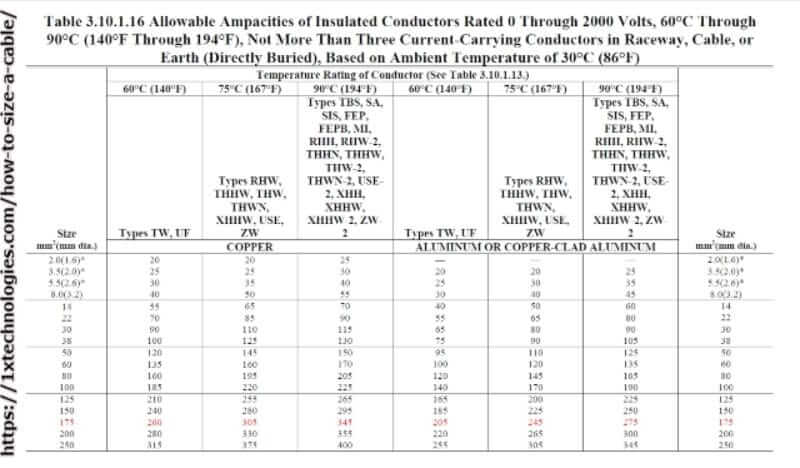
To make that cable sizing adjustment, multiply these three numbers together:
- Table 310.16 ampacity
- Temperature correction factor
- Bundling adjustment factor.
Always remember that the higher insulation temperature rating of 90°C rated conductors provides a greater conductor ampacity for use in ampacity adjustment, even though you size those conductors based on the column that corresponds to the temperature listing of the terminals [110.14 (C)(1)]. When correcting or adjusting conductor ampacity, use the temperature insulation rating of the conductor as listed in Table 310.16, not the temperature rating of the terminal [110.14(C)].
If a single length of conductor has two ampacities, use the lower ampacity for the entire circuit [310.15(A)(2)]. An exception applies: If that portion of the conductor with reduced ampacity is not longer than 10 feet and is not longer than 10% of the length of the part of the circuit with the higher ampacity, then you can use the higher ampacity for the entire circuit [310.15(A(2) Ex] (Fig. 3 on page 46).
Cable sizing with Current-carrying conductors
Table 310.15(B)(2)(a) adjustment factors apply only when there are more than three current-carrying conductors bundled together. All phase conductors are considered current-carrying, but what about other conductors?
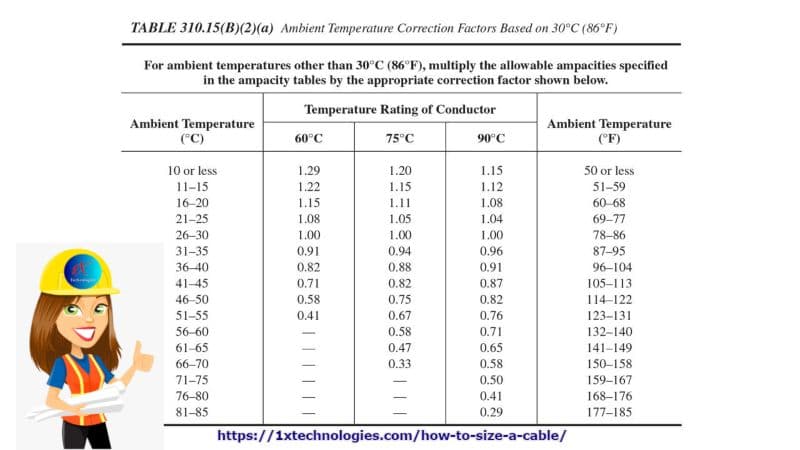
Here’s the rundown:
- Grounding and bonding conductors [310.15(B)(5)]Grounding and bonding conductors are never considered current carrying. Don’t count grounding and bonding conductors when adjusting conductor ampacity for the effects of conductor bundling [310.15(B)(5)]. They do, however, occupy space in the raceway and are included in raceway fill calculations (see Chapter 9, Table 1, Note 3), so you are accounting for their presence. You just aren’t counting them as current-carrying conductors.
- 2-wire circuits neutral and ungrounded conductors of a 2-wire circuit are considered current carrying.
- Neutral conductor — unbalanced loads [310.15(B)(4)(a)]A neutral conductor that carries only the unbalanced current from other conductors of the same circuit is not considered a current-carrying conductor (Fig. 4 on page 48).
- Neutral conductor — unbalanced 3-wire wye circuit [310.15(B)(4)(b)]The neutral conductor of a 3-wire circuit of a 4-wire, 3-phase, wye-connected system carries about the same current as the line-to-neutral load currents of the other conductors. As a result, it’s considered a current-carrying conductor.
- Neutral conductor — nonlinear loads [310.15(B)(4)(c)]The neutral conductor for a 4-wire, 3-phase wye circuit is considered a current-carrying conductor where more than 50% of the load consists of nonlinear loads (Fig. 5).
Nonlinear loads supplied by a 4-wire, 3-phase, 120/208V or 277/480V wye-connected system can produce unwanted and potentially hazardous harmonic currents. Odd triplen harmonic currents (3rd, 9th, 15th, etc.) can add on the neutral conductor. To prevent fire or equipment damage from excessive harmonic neutral current, consider increasing the size of the neutral conductor or installing a separate neutral for each phase. See 210.4(a) FPN, 220.61(C) FPN No. 2, and 450.3 FPN No. 2.
Meeting minimums of conductor size when choosing your cable size
From an NEC standpoint, conductors must be of a certain size to prevent a fire [90.1(B)]. This is the minimum conductor size, not necessarily the recommended conductor size. From an operational efficiency standpoint, you should size conductors to reduce voltage drop and/or to cope with nonlinear loads. Other reasons for exceeding NEC minimums may also apply.
If your installation doesn’t even meet the NEC requirements, it will fail to meet other requirements that may also exist (such as those for operational efficiency). To prevent that, remember the ampacity of a conductor changes with changing conditions. Part of your job in sizing conductors is to anticipate what those conditions will be. To determine the correct ampacity, you have to determine:
- Allowable ampacity, as listed in Table 310.16.
- Ambient temperature correction factors, if the ambient temperature is not 86°F.
- Conductor ampacity adjustment factors, if four or more current-carrying conductors are bundled together.
The last two items are where things can get dicey if you don’t do your homework. Find out what the ambient temperature will be along the entire length of each conductor. Such things as cable routing [see the example in Appendix D3(a)] and ventilation can change ambient temperature considerably, so take the time to review the entire installation — not just the electrical drawings.
If you correctly anticipate the ambient temperatures and perform the necessary ampacity adjustments, then you’ll meet the NEC minimums for conductor sizing. From there, you can decide whether to allow for other considerations in making a final determination of conductor size.
Resistance and Voltage Drop Calculator via YouTube Video (14 Minutes 16 Seconds)
This is a very good video from Dunwoody College teaching resistance and voltage drop you may use for your Traction Power Cable calculations.
Dunwoody College’s Elftmann Student Success Center invites you to enhance your learning of wire resistance and voltage drop. This will help you advance your Traction power cable calculations.
About 1X Technologies Cable Company.
Welcome to 1X Technologies Cable Company.
We’re Here Because You Require Quality, Quickly ®.
We’re a leading United States electrical cable manufacturer headquartered in beautiful Wyoming USA, serving a broad & diverse customer base around the world!
We excel in supplying you with advanced, top of the line cable, FAST.
Yes, we have the rarest cables in stock, but our cable manufacturing speed & flexibility are truly your secret weapons.
When you need a product that’s not in stock, we will make it as rapidly as 24 hours from your order placement.
We consistently ship your made-to-order cables faster than our competitors can ship from stock. Pretty amazing, right?
Think of 1X Technologies when you need high-temperature wires up to fourteen-hundred degrees C, custom cables, and HUGE copper power cables up to 6000 MCM.
Working on anything we can help you with today?
Remember, When your project needs a hero call 888-651-9990.
Think of 1X Technologies Cable Company for:
- Belden Cable Equivalent Manufacturer, Belden Cable Price List, Belden Cable Cross Reference using our unique Belden Cable Finder.
- XL MCM & KCMIL Sizes when you need it now! 500 MCM, 600 MCM, 750 MCM, 1000 MCM, 1100 MCM, 1250 MCM, 1500 MCM, 2000 MCM, 2500 MCM, 3000 MCM, 3500 MCM, 4000 MCM, 4500 MCM, 5000 MCM Copper Cable and Aluminum Cable.
- High-Temperature Wire, high temp cable manufacturing.
- Multi-Conductor Industrial Cables
- Just about every type of wire & cable you can imagine with millions of feet of Wire & Cable Products in stock.
Our Mission:
“Because You Require Quality, Quickly!®”
“It is the Mission of 1X Technologies LLC to provide electrical professionals with advanced Wire & Cable related products and knowledge that completely fulfills their requirements. We offer value through speed, ingenuity, and the ability to provide unique solutions that others can’t. Our friendly, knowledgeable, and professional staff will truly go the extra mile to help inspire, educate, and problem-solve for our customers. We’re here Because You Require Quality, Quickly ®
Our Vision:
We’ll do what others won’t. We’ll provide you value others can’t.
Our vision is to be the ultimate specialty wire and cable company in the world. We’ll relentlessly focus on finding new and better avenues to offer you unprecedented value.
Our purpose is to innovate, create, and design advanced cable solutions that further technologies throughout the world. Additionally, we are working to build more than a wire & cable dynasty. Specifically, we are in the business of giving back to the communities we all work and live in.
By focusing on our unprecedented abilities to offer you value in specialty wire & cable, we can use our mutual success as a machine for manufacturing good will for our stakeholders through charity and giving back to our community.
Top 100 Questions we get every day on “How to Size a Cable” and related questions:
-
how to size a cable tray (Don’t ask us why! #1)
-
how to size a cable gland (Yes we sell glands)
-
how to size a cable
-
how to measure a cable size
-
how to size a power cable
-
how to size a dc cable
-
how to size a hv cable
-
how to size a battery cable
-
how to size a electrical cable
-
how to size cable for star delta motor
-
how to size a cable for a motor
-
how to size armoured cable
-
how to size an electrical cable
-
how to size an earth cable
-
how to select a cable size according to load
-
how to size marine battery cable
-
how to measure battery cable size
-
how to size cable for capacitor bank
-
how to size cable conduit
-
how to size control cable
-
how to cable size calculation
-
how to choose a cable size
-
how to measure cable drum size
-
how to determine a cable size
-
how to design a cable size
-
how to size earth cable
-
how to measure cable size electrical
-
how to size service entrance cable
-
how to size cable in etap
-
how to size transformer neutral earthing cable
-
how to size cable for transformer
-
how to size cable for vfd
-
how to size conduit for cable
-
how to size trunking for cable
-
how to select a cable size for particular load
-
how to calculate size of cable for motor
-
how to size grounding cable
-
how to size generator cable
-
how to measure cable gland size
-
how to tell what size a cable is
-
how to size instrument cable
-
how to size cable ladder
-
how to calculate cable size for a particular load
-
how to size mv cable
-
how to size mi cable
-
how to measure cable size mm
-
how to measure cable size mm2
-
how to measure cable size uk
-
how to calculate cable size for a motor
-
how to select cable size for a motor
-
how to size a neutral cable
-
how to size ngr cable
-
how to measure size of cable
-
how to size fiber optic cable
-
how to calculate size of cable
-
how to calculate size of cable pdf
-
how to calculate size of cable tray
-
how to determine size of cable
-
how to check size of cable
-
how to select size of cable
-
how to identify size of cable
-
how to size 3 phase cable
-
how to measure power cable size
-
how to calculate cable size for a particular load pdf
-
how to size swa cable
-
how to size shower cable
-
how to size speaker cable
-
how to size solar cable
-
how to select a cable size
-
how to size cable trunking
-
how to size the cable
-
how to size up cable tray
-
how to size heat trace cable
-
how to measure the cable size
-
how to determine the size of a cable
-
how to size vfd cable
-
how to size medium voltage cable
-
how to size high voltage cable
-
how to size low voltage cable
-
how to size welding cable
-
how to measure welding cable size
-
how to work out a cable size
-
how to size 11kv cable
-
cable size for 5 kv
-
How to size 1000 MCM Cable
-
how to size electrical wire for distance
-
how to size underground electrical wire
-
how to measure electrical wire size
-
how to properly size electrical wire
-
how to size electrical service wire
-
how to size electrical ground wire
-
how to compute size of electrical wire
-
how to tell size of electrical wire
-
how to check size of electrical wire
-
how to size an electrical wire
-
how to determine the wire size for an electrical run
-
how to size electrical wire for use
-
how to size wire gauge for electrical current
-
how to measure electrical wire length
-
Where to find electrical wire measuring tool
Cable Sizing Disclaimer:
1X Technologies Cable Company has made every effort to ensure that the results of this article are correct and helpful to you on your job. However, we advise you to reference your NEC handbook to double-check all your work. We disclaim all liability from usage of this information in cable sizing.

